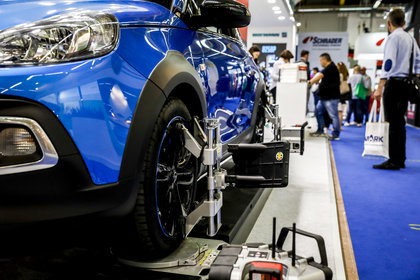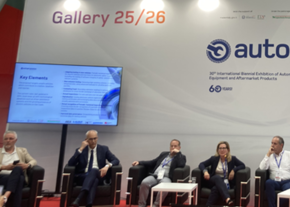
31/08/2021
The new machinery directive
Massimo Brunamonti
The long process needed to revise the Machinery Directive (2006/42/EC) came to an end on 21 April, when the European Commission presented the proposal for a new Regulation
The long process needed to revise the Machinery Directive (2006/42/EC) came to an end on 21 April last, when the European Commission presented the proposal for a new Regulation, and this is already a great piece of news: proposing a regulation to replace an already existing one reveals the need for a more homogeneous and effective legislative device, not subject to possible differences due to its implementation by all member states, which was one of the issues raised as delays and significant differences existed between the member states of the Union.
The primary purpose of the new regulation is to update the legislation and its essential requirements to fit the latest technological developments, including human-robot interaction, and to remove possible loopholes in safety requirements. Among the main innovations found in the new bill, one deserves to be mentioned: the adoption of a new legislative framework for placing a product on the market, introducing, in addition to the manufacturer, also the importer and the distributor with safety-related roles. The importer, like the manufacturer, is responsible for the conformity of the product and is personally liable for it, while the distributor has the duty to verify that the product is correctly identified and documented and to ensure that the transport and storage of the product do not compromise safety. But perhaps the most important novelty concerns new technologies and the impact these will have on human safety, including robots, autonomous vehicles, IoT (Internet on Things), artificial intelligence (AI), and self-learning machines (ML). In the case of AI and ML, the new regulation deals only with the safety aspect, however the issues related to them are so all-encompassing that the Commission has decided to devote a specific regulation designed to cover the subject in its entirety. In view of the proposals for amendments received from member states, the organization of the Annexes has been modified. In particular, the list of "high risk" machines, Annex 4 in the old Directive, has become Annex 1 and the safety requirements to which such machines must be subject are indicated in Annex 3, following the structure of other similar regulations. It should be noted that, unlike before, the new regulation provides that every machine of the type listed in Annex 1 must be checked for conformity by an approved lab, thus excluding self-certification procedures provided by Directive 2006/42/EC. And this has been immediately criticized; according to some, this obligation of third-party certification will cause higher costs and administrative burdens as well as longer marketing times. In addition to this, Orgalim, the federation representing the European hi-tech industry, voiced its concerns about the introduction of new requirements related to digital technologies that may constitute a limitation for an industry that must, by its nature, remain versatile, agile and innovative. The Commission, on the other hand, felt that the regulation was necessary to promote a sustainable post-pandemic recovery for a sector that is one of the industrial pillars of the EU economy, avoiding critical issues and regulatory gaps. The old directive does not sufficiently cover the risks arising from emerging technologies, including risks related to human-robot interaction and the problems of managing increasingly connected machines and equipment.
The Commission also highlights the effort made to digitize processes and documents, emphasized in the new regulation, in an attempt to restrict the use of paper in line with European policies of sustainability. As far as garage-equipment goes, in addition to the overall structure of the regulation, which obviously concerns all the operators in the sector, there are no significant news as far as high-risk machines included in Annex 1 are concerned: it simply repeats the list found in Annex 4 in the old Directive. Garage lifts remain as the only high-risk pieces of equipment. The news, however, is that, as mentioned before, with the coming into force of the new regulation manufacturers of garage lifts will no longer be able to rely on self-certification procedures, even for a high-quality system, but will have to submit their products to conformity verification by an approved third party that will issue the appropriate certification valid for five years. It should also be noted that while the Machinery Directive applies to new machinery and has never considered modifications to older machines, the new regulation also applies to products that have undergone "substantial modifications", such as to affect their compliance with safety requirements; for these substantial changes the person or company responsible for making them will have to meet all the obligations that the regulation provides for manufacturers. The new regulation proposed by the Commission has reached the public consultation phase until July 22, after which the discussion process with the Parliament and the Council will begin. The new Machinery Regulation will come into force on the twentieth day after its publication and will be applied after a further 30 months, automatically repealing the old Directive 2006/42/EC; operators will also have an additional time window of 42 months to place on the market machines complying with the old Directive 2006/42/EC, after which only those complying with the new Regulation will be able to legitimately enter the EU market.
The primary purpose of the new regulation is to update the legislation and its essential requirements to fit the latest technological developments, including human-robot interaction, and to remove possible loopholes in safety requirements. Among the main innovations found in the new bill, one deserves to be mentioned: the adoption of a new legislative framework for placing a product on the market, introducing, in addition to the manufacturer, also the importer and the distributor with safety-related roles. The importer, like the manufacturer, is responsible for the conformity of the product and is personally liable for it, while the distributor has the duty to verify that the product is correctly identified and documented and to ensure that the transport and storage of the product do not compromise safety. But perhaps the most important novelty concerns new technologies and the impact these will have on human safety, including robots, autonomous vehicles, IoT (Internet on Things), artificial intelligence (AI), and self-learning machines (ML). In the case of AI and ML, the new regulation deals only with the safety aspect, however the issues related to them are so all-encompassing that the Commission has decided to devote a specific regulation designed to cover the subject in its entirety. In view of the proposals for amendments received from member states, the organization of the Annexes has been modified. In particular, the list of "high risk" machines, Annex 4 in the old Directive, has become Annex 1 and the safety requirements to which such machines must be subject are indicated in Annex 3, following the structure of other similar regulations. It should be noted that, unlike before, the new regulation provides that every machine of the type listed in Annex 1 must be checked for conformity by an approved lab, thus excluding self-certification procedures provided by Directive 2006/42/EC. And this has been immediately criticized; according to some, this obligation of third-party certification will cause higher costs and administrative burdens as well as longer marketing times. In addition to this, Orgalim, the federation representing the European hi-tech industry, voiced its concerns about the introduction of new requirements related to digital technologies that may constitute a limitation for an industry that must, by its nature, remain versatile, agile and innovative. The Commission, on the other hand, felt that the regulation was necessary to promote a sustainable post-pandemic recovery for a sector that is one of the industrial pillars of the EU economy, avoiding critical issues and regulatory gaps. The old directive does not sufficiently cover the risks arising from emerging technologies, including risks related to human-robot interaction and the problems of managing increasingly connected machines and equipment.
The Commission also highlights the effort made to digitize processes and documents, emphasized in the new regulation, in an attempt to restrict the use of paper in line with European policies of sustainability. As far as garage-equipment goes, in addition to the overall structure of the regulation, which obviously concerns all the operators in the sector, there are no significant news as far as high-risk machines included in Annex 1 are concerned: it simply repeats the list found in Annex 4 in the old Directive. Garage lifts remain as the only high-risk pieces of equipment. The news, however, is that, as mentioned before, with the coming into force of the new regulation manufacturers of garage lifts will no longer be able to rely on self-certification procedures, even for a high-quality system, but will have to submit their products to conformity verification by an approved third party that will issue the appropriate certification valid for five years. It should also be noted that while the Machinery Directive applies to new machinery and has never considered modifications to older machines, the new regulation also applies to products that have undergone "substantial modifications", such as to affect their compliance with safety requirements; for these substantial changes the person or company responsible for making them will have to meet all the obligations that the regulation provides for manufacturers. The new regulation proposed by the Commission has reached the public consultation phase until July 22, after which the discussion process with the Parliament and the Council will begin. The new Machinery Regulation will come into force on the twentieth day after its publication and will be applied after a further 30 months, automatically repealing the old Directive 2006/42/EC; operators will also have an additional time window of 42 months to place on the market machines complying with the old Directive 2006/42/EC, after which only those complying with the new Regulation will be able to legitimately enter the EU market.






